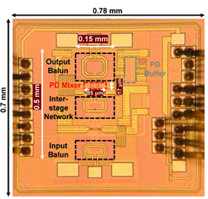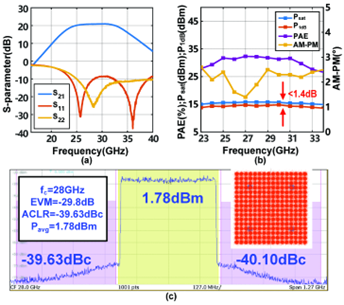
25-31 GHz Power Amplifier with Integrated Power Detection
The research team proposed a compact and high-performance power detector based on self-mixing architecture. By optimizing the position of the coupling port, differential voltage and current detection under single-ended power output is achieved, avoiding the area overhead caused by the additional single-turn differential balun. In addition, through the quantization analysis of the transfer function, an endogenous phase compensation method that does not rely on an external phase-shifting unit is proposed to ensure accurate power detection under load mismatch. In the design of the self-mixer, a current extraction technique is used to optimize the low-frequency flicker noise of the mixer and improve the overall dynamic range. Combining the above technologies, the team designed a small-area, high-dynamic-range, voltage VSWR-resistant, non-intrusive power detector for Ka-band satellite communications and integrated it into a millimeter-wave power amplifier. The power detector can realize a dynamic range of greater than 33dB in the range of 25~31GHz; when the voltage VSWR at the load end is 2:1/3:1, the power detection error in the band is less than ±1.5dB/±3.8dB, respectively; and the core area of the power detector is only 3520μm2.
The related results were published in the 2024 RFIC conference, with master's student Haoqi Qin and doctoral student Junjie Gu of the School of Microelectronics, Fudan University, as co-first authors.
Paper Link:
Qin, H., Gu, J., Xu, H., Xu, Z., Jia, P., & Yan, N. (2024). A 25-31GHz Compact True Power Detector with >33dB Dynamic Range in 40nm Bulk CMOS. 2024 IEEE Radio Frequency Integrated Circuits Symposium (RFIC), 135–138.





